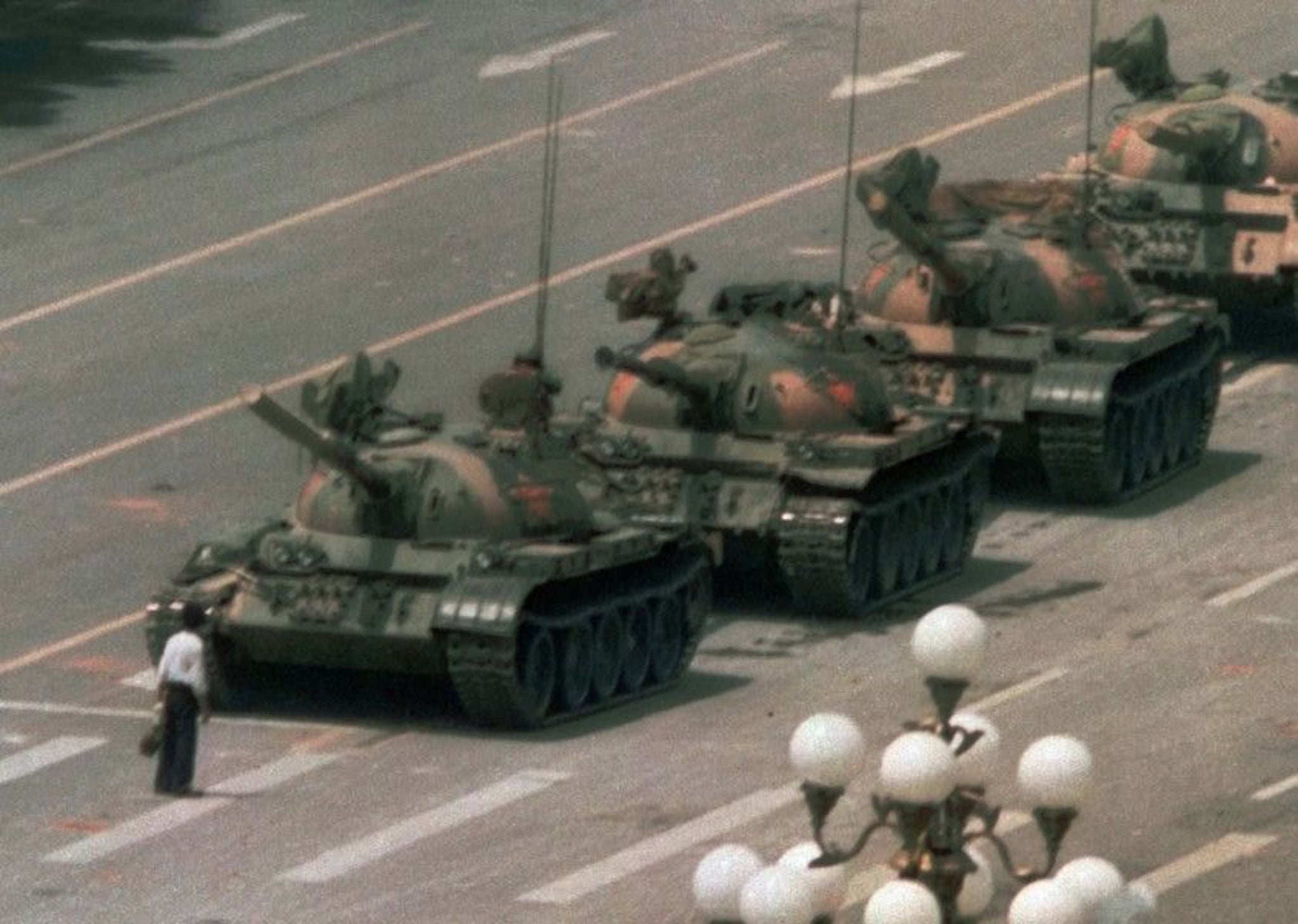Tiananmen Square massacre – 30 years since the largest political protest in communist China’s history came to a bloody end
Tiananmen Square massacre – 30 years since the largest political protest in communist China’s history came to a bloody end
HE was armed with just a jacket and a book-bag, but he still believed he was perfectly equipped to halt a column of tanks.
The photograph of “tank man” both inspires and shames us. It’s impossible not to feel admiration for the man’s superhuman courage, but the viewer also feels an overwhelming sense of impotence and rage. His cause was already lost and nobody in the West could help him escape. It remains the defining image of the aftermath of the atrocities in and around Tiananmen Square, which saw the leaders of China’s communist party unleash the army on peaceful protests for freedom and democracy.
But, amid the slaughter, there was still a belief that reason could win the day. During the worst of the carnage, a lone man walked into the centre of the road to halt the tanks’ advance. The convoy halted. As the lead tank moved towards the right, and then the left, the man moved to stop it. According to witnesses, the man climbed on the tank and shouted: “Go back. Stop killing my people.”
Finally, onlookers rushed to guide him off the road. The tanks rolled on. The man’s name and fate is unknown. Others may have staged a similar protest away from the cameras, but it is the image of a single man staring downed armed forces that sums up the heroism and futility of the Chinese protests of 1989.
In popular memory, 1989 is remembered as one of the great turning points in world history, when Communism lost its icy grip on Eastern Europe, largely because Mikhail Gorbachev, the Soviet leader, would not use violence against dissenters. Elsewhere, the apartheid regime in South Africa was about to enter its death throes.
The events in Tiananmen Square represented a bloody anomaly, a throwback to a darker era. Thirty years ago, China’s communist party leaders ruthlessly eliminated protesters who challenged their authority, after a stand-off that had simmered for two months. The protests started after the death of the popular reformer Hu Yaobang in April and were led by students around the country, who were calling attention to the flaws and contradictions in the Communist Party’s Leninist structure. They were also outraged by widening social inequality and corruption.
“The social movement of spring 1989 and the Chinese Communist Party’s crackdown on it represented the violent resolution of tensions between conservatism and liberalism which had grown in China in the previous decade,” says Dr Adam Cathcart, lecturer in Chinese History at the University of Leeds.
The students appeared to have good reason to believe history was on their side. “They were very aware of what was happening in the Soviet Union and Eastern Europe” says Dr Cathcart.
“They wanted greater personal freedoms and an opening up for political participation beyond the stultifying confines of party organisations in their universities and workplaces.”
“The movement expanded quickly with the student leadership drawing on traditions and patterns of protest and centrality which had been carved out at various critical junctions of China’s turbulent 20th century. They soon brought in labourers and, perhaps most dangerous to the party, workers in the propaganda organs of the Chinese Communist Party itself.”
In late April, China’s ruler Deng Xiaoping, ordered a strongly-worded editorial in the state’s mouthpiece, The People’s Daily, denouncing the students for attempting to “negate” the Socialist system. The students, who were gathering in Beijing’s vast Tiananmen Square to air grievances, were undeterred. In May, Gorbachev flew into China for a summit and the students organised their biggest demonstration, which attracted one million people. Some staged hunger strikes. While Gorbachev was kept well away from the protesters, more liberal members of the ruling party made fruitless attempts to persuade the students to leave Tianenman Square.
The world hoped and waited. Then after a long and, for the Communist hardliners, embarrassing impasse, Deng imposed martial law, with the backing of Standing Committee of the Central Committee. On June 3, the People’s Liberation Army was ordered to turn its guns on the people of Beijing to end the protests for good.
In their book, Tiananmen, Michael Fathers and Andrew Higgins, who were journalists working for The Independent, recalled the protesters’ brave defiance. “At the eastern end of Tiananmen Square near the Peking hotel, the army shot at civilians for the crime of coming too close, this time dozens of unarmed cyclists . ‘Animals, Animals’ shouted the survivors. Beneath the gate of Nananchizi Street, near Tiananmen, an old woman sat wailing, screaming for vengeance: ‘Assassins. Dogs. You murdered my husband.’
“Raiding parties of armoured vehicles and troop trucks patrolled up and down Changan, shooting sporadically but often murderously. Buildings and lampposts across the city were plastered with scribbled notes denouncing the army; besides some, the photographs of young men and women, shot dead in the violence.”
Estimates of the death toll range from several hundred to several thousand. The Chinese authorities’ claimed that 200 civilians and several dozen security personnel had died in Beijing following the suppression of “counter-revolutionary riots”. It had been a textbook expression of state brutality.
“The government’s response to the protests was so harsh and unequivocal that it would be difficult to say that the movement had lasting change within China,” says Dr Cathcart. “The leaders of the protest were either imprisoned or forced into exile in Hong Kong, then still British, or Taiwan or the United States. University exams were cancelled and students who wished to return in the autumn had to write extensive self-criticisms.
“The carnage on the streets of Beijing was turned into a ‘counterrevolutionary rebellion’ which the army had selflessly defended against, and the incident was repressed in the country’s state media and ultimately history books.
“It contributed to the further disillusionment of the youth in China, who are now middle-aged, and the turn toward more material rather than political or spiritual pursuits for many. The party turned to more aggrieved nationalism in its propaganda and education domestically, rather than Marxism or Maoism, to garner loyalty.
“And it hardened the image of China abroad into a country of harsh authoritarianism, artistic restrictions, and political limitations, even as the economy grew.”
Wherever there is a yearning for freedom, the Chinese democracy movement of 1989 will be an inspiration, a lesson and a warning.
Three decades later, the student protesters’ raw idealism retains its power to trouble our consciences.
“When confronting the army in the last dreadful moments before Tiananmen Square was cleared, the student leaders refused to arm themselves, saying: ‘We demonstrate in peace, and the most supreme principle of peace is to give up our lives’,” wrote the journalist Andreas Whittam Smith on the infamous events.
“Many made the supreme sacrifice, and thus elevated their defeat into an event of enormous resonance.
“Like the Hungarian uprising of 1956 and the Prague Spring of 1968, it has become one of those few, seemingly lost, causes which stay forever in the mind.”







